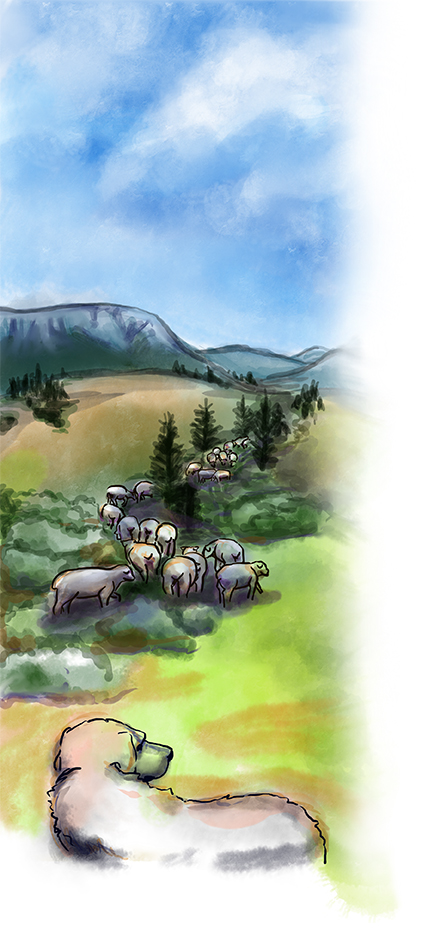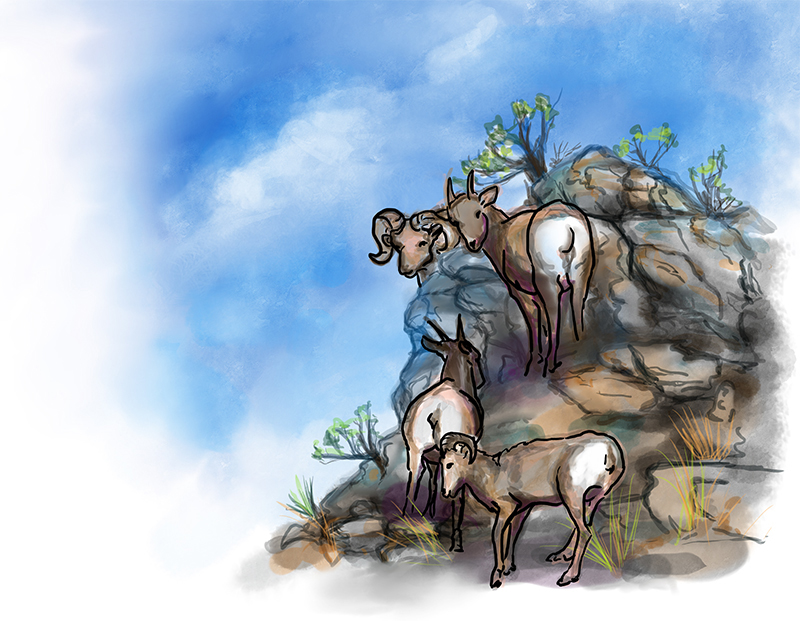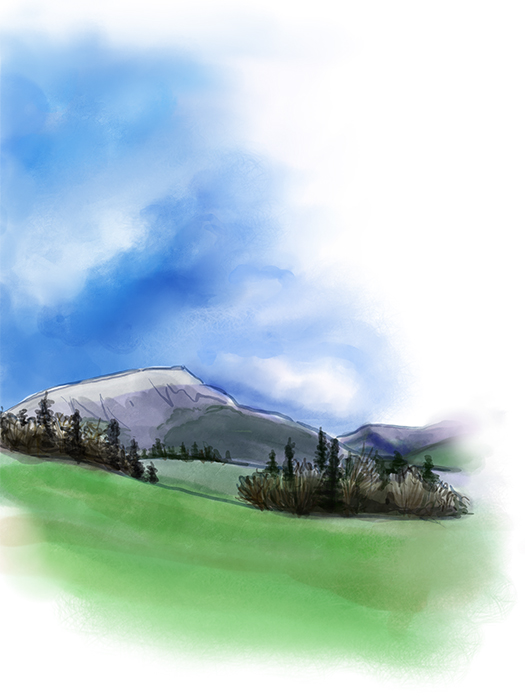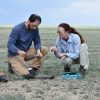A court case challenges domestic sheep grazing on national forests
In any court case, there are two sides. But in a wood-paneled courtroom at the Federal Building and United States Courthouse in Butte, Montana, differences between the two sides headed to court were not immediately apparent. Both groups of men and women assembled there in early March wore the practical vests, collared shirts, and dark blue jeans common to the mountain West. Both groups had left a chilly, blue-sky day to enter the courthouse. They emptied their pockets, left their phones with security and passed through a metal detector. Once the bailiff invited them into the courtroom, they sat in quiet clusters and waited for the judge to enter the chamber.

In one group, 59-year old Glenn Hockett gripped a notebook that held printouts of scientific papers he would refer to in a statement before the judge. He is the president of a small, all-volunteer, non-profit group called the Gallatin Wildlife Association and lives in Bozeman, Montana.
In 2015, his group sued the United States Forest Service to stop sheep ranchers from grazing public land in the Gravelly Mountains of southwestern Montana. At this latest hearing, the judge would consider their request for an emergency order to halt grazing in the Gravellys. It was the fifth such request they’ve made in addition to various motions and appeals that have moved the case forward intermittently during the past three years.
The group’s main argument is that domestic sheep hinder their use and enjoyment of public lands, primarily by threatening the survival of already-imperiled bighorn sheep, an ionic creature of the mountain West. Domestic sheep carry respiratory diseases that can kill bighorn sheep. Bighorns don’t currently live in the Gravellys but one herd roams neighboring peaks to the north. Hockett and his group think the grazing allotments prevent the bighorns from moving into suitable habitat in the Gravellys. If they prevail, the case could change the future of grazing on public lands throughout the West.
The second group in the courthouse included two sheep-ranching families that live near the small town of Dillon, Montana. As they gathered, they exchanged comments about the courthouse security process, a routine that had become distressingly familiar. Among them was John Helle, 54, a third-generation sheep rancher and managing partner of Helle Livestock. If the judge issues an emergency order, these families would have to scramble to find new summer grazing land for thousands of sheep. It could be devastating to their livelihoods, Helle says.
The case is just one of several challenging sheep-grazing rights in recent years. Vulnerable bighorns, public land allotments for domestic sheep, and the evolving culture of the new West form a potent mix for conflict. At the heart of the issue is the challenge of balancing wildlife conservation on public lands with natural resource uses that support the livelihoods, character, and open landscape of the West. Sheep ranchers, with their long history in the region, want to remain on allotments administered by the U.S. Forest Service and the Bureau of Land Management. Wildlife advocates counter that domestic sheep hinder the reestablishment of healthy bighorn sheep populations. Individuals from both sides comb through scientific literature to find support for their views. They come to very different conclusions about what should be done for sheep management.
Nearly two million bighorn sheep once occupied the West, but their numbers plummeted to a few thousand by the early 1900s due in part to overhunting. Disease was another major factor. Domestic sheep are the carriers of respiratory illnesses to which bighorns have no resistance, experts now think. Once a herd contracts one of these illnesses, the pathogens remain in survivors and infect new lambs—a pattern that has affected herds across the West. Although restoration efforts bolstered the population to about 80,000 today, many herds remain small, isolated, and therefore easily killed off entirely.
In the court room that day, four different attorneys presented arguments to U.S. District Court Judge Brian M. Morris. Previously, Judge Morris had declined to halt grazing, though in 2016 he ruled that the Forest Service had failed to fully consider the impacts of two agreements made with sheep ranchers, didn’t disclose the agreements to the public, and violated the National Environmental Policy Act in the process. Part of the agreements detailed that the ranchers should shoot on sight any bighorn spotted near domestic sheep. That dramatic action was posed as the last chance that mangers had to ensure that an individual bighorn sheep wouldn’t take disease back to its herd. But it gave authority and responsibility to ranchers.

This time, the Judge Morris reminded the Forest Service of that failure and emphasized that they had not stuck to their own proposed schedule for resolving the issue. The judge added that unfortunately, the people who suffer the consequences of the delay are the two sheep ranching families that graze the allotments. “I have protected them so far,” he said. “But at some point, the Forest Service has to do its duty and follow the law.”
Both sides would have to wait weeks for Judge Morris to issue his next decision.
In a Bozeman coffee shop a few weeks later, Hockett explained that his passion for bighorns goes back decades. In the early 1980s, he advocated for bighorn sheep to be reintroduced in the Tendoys, a mountain range about 50 miles southwest of the Gavellys. “I kind of grew up with this herd,” he says. “I watched it, knew it, went over there to view it.” In 1993, he drew a hunting tag for a ram in the Tendoys herd, which at that time numbered more than 150 animals. His wife, Laurie, drew a ewe tag the same year. The hunt was successful and, to the Hocketts, a celebration of conservation efforts that created a herd viable enough to be sustainably hunted. But the winter after the hunt, pneumonia swept through the herd. Montana Fish, Wildlife and Parks counted only 28 sheep later that year, none of them lambs. “It was really disheartening, really shattering,” Hockett says.
If any bighorn sheep still roam the Tendoys, they are likely the last of that herd. After the animals struggled for years against respiratory illnesses, Montana Fish Wildlife and Parks issued unlimited hunting tags in 2016 with the goal of eradicating the remainder of the Tendoys herd. With a clean slate, the agency could reintroduce healthy bighorns to the range in the future.
Given the risk to bighorns, wildlife managers encourage separation between domestic and wild sheep. Montana Fish Wildlife and Parks’ conservation strategy requires domestic sheep to stay 14 miles away from bighorns. Yet domestic sheep, whose meat, milk, and wool helped European-Americans settle the West, often live near or in suitable bighorn sheep habitat. Some of those lands are grazing allotments on public lands historically established for livestock use. While many domestic sheep grazing allotments have been retired due to declines in demand for wool as synthetics arose, some still remain.
In early April, the domestic sheep that graze the allotments in the Gravelly mountains started lambing. Helle checked on the progress in his lambing and shearing barn. There, three ranch hands moved between pens, working together to scoop up newborn lambs and dip their umbilical cords in disinfectant. Helle greeted them and then surveyed hundreds of ewes milling in a fenced yard out in the sun, still round with their unborn young.
“I’m just super, super frustrated with the whole thing right now,” Helle says. He fears that the goal of the lawsuits is to disrupt ranching operations, rather than arrive at a conclusion informed by best management practices. “I don’t think it’s a way that we solve any issues here in the West, where we’ve been conservation-minded ranchers for years.”
Finding last-minute summer grazing grounds for the 10,000 sheep the ranch shears every year could prove impossible, Helle says. Even if land were available, the change would jeopardize his business. The Rambouillet breed the ranch keeps produces soft, curly wool for Duckworth, Inc., an apparel company co-owned by Helle that produces long underwear, pullovers, and more. In a declaration submitted to the court, Helle argues that the cool summers their sheep spend in the Gravellys’ high country are responsible for Duckworth wool’s unique properties.
On his ranch, Helle looked over the backs of the ewes waiting to lamb and up a series of sage- and grass-covered benches toward the Gravelly Mountains. His sheep would take a meandering path across that landscape later that spring to reach national forest land in the mountains by July 1. “All this land evolved under grazing of some sort, whether it’s buffalo, bighorn sheep, or deer,” Helle says.
Like many in agriculture, Helle has a strong sense of stewardship over the land where he lives. Classes in range management and animal science at Montana State University supplement his years of observations and generational knowledge about the lands his sheep graze. “If you don’t graze it, it tends to get really rank and prone to fire,” he says. “When you remove grazing, it’s just like if you removed fire from timber: You get a non-succession type vegetation.” Grazing the land keeps it open and available for bighorn sheep to use it as their winter range, he says.

Helle pulled out his iPad to show photos of the sheep in the high country last summer. He pointed beyond the grazing sheep in one photo to slopes covered with dead trees. Whitebark pine, killed by bark beetles. But a few green trees still stand amid the dead ones. He wondered if they have some kind of resistance to infestation. He sees a clear parallel to bighorn sheep.
Helle said he finds it puzzling that after a bighorn herd suffers a die-off, wildlife managers may kill the remaining animals. “Applying my genetic and animal selection science to that, I’d say ‘Wow, those sheep survived.’” Perhaps those are the sheep to keep around, not to kill off.
Hockett also looks to science to support his position. In the Bozeman coffee shop, Hockett paged through his printouts of scientific studies. He paused conversation to find a particular highlighted passage. Montana Fish Wildlife and Parks says that minimum number of bighorns needed to create a self-sustaining herd is 125, but Hockett’s highlighted passage— a technical discussion about the genetics of small populations—pushes that number up to 200. He can rattle off the official population counts of bighorns in the mountains north of the Gravellys for the past several years. “They’ve never counted over 80,” he says. Given his read of the science, that means the group isn’t likely to survive without a chance to expand into the Gravellys themselves. He says he fears that politics are overshadowing scientific understanding.
As in all scientific fields, the actual research surrounding bighorn sheep and disease is ever evolving. Helle is right, some bighorns don’t die after exposure to pathogens. Robert Garrott, professor of ecology at Montana State University in Bozeman is learning what he can from those survivors. He runs two ongoing projects—one surveying bighorn herds in and around Yellowstone National Park and another studying herds across Montana. Nearly 4,000 bighorn sheep live in connected herds east of Yellowstone, thriving when other herds have failed. Garrott and his colleagues sampled more than 20 herds in and around Yellowstone, swabbing their noses and tonsils for pathogens that cause respiratory diseases. They’ve found that about 75 percent of the herds already have bacteria suspected to cause die-offs including pneumonia-causing species of Pasteurellaceae and Mycoplasma ovipneumoniae.
“That was very different from what people were thinking,” Garrott says. Many of the herds appeared healthy. The findings tell Garrott that not all die-offs may be caused by recent contact with domestic sheep. Many could be caused by bacteria already in the herd that flare up and kill due to some additional stressor or genetic weakness scientists have yet to understand.
Does that mean that Helle’s sheep could graze in the Gravelly’s alongside bighorns without fear of disease transmission? No, Garrott explains that much more research would be needed to draw such a strong conclusion. For now, bighorns are best protected by the 14-mile separation. The differences in whether bacteria can cause sickness and spread quickly likely vary from strain to strain. Even if a particular herd of bighorn has the same species of bacteria as a herd of domestic sheep, different strains could cause new die-offs.
In the meantime, agencies have to make management decisions with current available science. The lag between new scientific findings and current management practices gives space for concerned individuals to step in through the legal system.
Hockett and the Gallatin Wildlife Association also have a case pending to halt grazing in another mountain range, where the Dubois, Idaho-based Agricultural Research Service Sheep Experiment Station grazes domestic sheep. These legal battles are part of a recent history of litigation challenging grazing allotments across the West. In some instances, the status quo and therefore the domestic sheep interests prevail. In a 2017 Wyoming case, the judge allowed the Forest Service to continue grazing allotments in the Medicine Bow National Forest because the bighorn population was viable in other areas of the Forest. In Idaho and California, the Forest Service closed portions of its lands to domestic sheep grazing allotments, sparking court challenges. In those cases, the decisions fell in favor of wild sheep conservation. In Utah, conservation groups have bought up grazing allotments from ranchers to get domestic sheep off the land and return habitat to bighorns. Many small battles add up to a landscape-wide conflict of push and pull between competing values.
In mid-April, Judge Morris denied the motion for an emergency order in the Montana case. Domestic sheep grazed this summer in the Gravellys, watched over by ranchers on horseback. In his ruling, the judge wrote that the Gallatin Wildlife Association did not meet the legal standards needed to justify an emergency order to halt grazing. Those standards are high and very little science figured into this particular decision. But the main case remains undecided, as the Gallatin Wildlife Association is appealing an earlier ruling.
Helle and Hockett will once again climb the steps of the courthouse in Butte to sit separately in the courtroom while their attorneys argue over the fate of two different species of sheep in the Gravellys.
By Maris Fessenden
Maris Fessenden is a freelance journalist and illustrator based in Bozeman, Montana. Find more of their work at marisfessenden.com.


